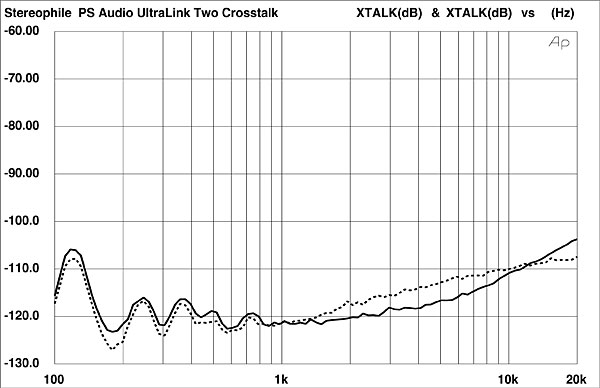| Columns Retired Columns & Blogs |
PS Audio UltraLink Two digital processor Measurements
Sidebar 2: Measurements
The UltraLink Two's maximum output level from the balanced jacks was a lowish 3.15V (balanced) and 1.58V (unbalanced). These low output levels we're starting to see in digital processors are caused by the 6dB of attenuation required in HDCD-equipped processors when decoding standard CDs (including test discs). This is still plenty of level to drive any preamplifier. Output impedance measured a low 160 ohms (balanced) and 78 ohms (unbalanced). DC levels were unmeasurable, and the UltraLink Two correctly decoded 32kHz and 48kHz sampling frequencies.
The UltraLink Two's frequency response was predictably flat, and the de-emphasis tracking was perfect (fig.1). In fig.2, the UltraLink Two's crosstalk, we can see excellent channel separation, but with power-supply noise intruding at 120Hz and its harmonics. I tried different grounding schemes, including a "cheater" plug on the UltraLink Two, but this noise remained. The channel separation was, however, greater than 105dB across the band.

Fig.1 PS Audio Ultralink Two, frequency response (top) and de-emphasis error (bottom) (right channel dashed, 0.5dB/vertical div.).

Fig.2 PS Audio Ultralink Two, crosstalk (R–L channel dashed, 10dB/vertical div.).
As with the EAD DSP-1000 reviewed elsewhere in this issue, the UltraLink Two was retrofitted with the PMD100 HDCD decoder/filter, and will not pass 20-bit data, although the PMD100 has a 24-bit–wide data path. All measurements were therefore made with 16-bit input word length. Fig.3 is a spectral analysis of the UltraLink Two when decoding a 1kHz, –90dB dithered sinewave. The overall noise level is low, except for the power-supply noise at 120Hz.

Fig.3 PS Audio Ultralink Two, spectrum of dithered 1kHz tone at –90.31dBFS, with noise and spuriae (16-bit data, 1/3-octave analysis, right channel dashed).
A wideband spectral analysis made with an input signal of all zeros (fig.4) shows some odd peaks of ultrasonic energy in the left channel. I've seen this in some other processors recently, but have no explanation for it.

Fig.4 PS Audio Ultralink Two, spectrum of digital silence (16-bit data, 1/3-octave analysis, right channel dashed).
Fig.5 is the UltraLink Two's linearity. We can see a slight negative error starting at –80dB. Although the error is minimal (it never exceeds 0.8dB), UltraAnalog DACs as used in the UltraLink Two usually have superb linearity. (See the measurements of the UltraAnalog-based Classé DAC 1 elsewhere in this issue for comparison.)

Fig.5 PS Audio Ultralink Two, departure from linearity (right channel dashed, 2dB/vertical div.).
The UltraLink Two's noise modulation plot (fig.6) shows the unit has relatively low, and only moderately tight, trace groupings. This noise-modulation performance is good, but not superlative.

Fig.6 PS Audio Ultralink Two, noise modulation, –60 to –100dBFS (10dB/vertical div.).
Fig.7 shows the UltraLink Two's reproduction of a 1kHz, –90dB undithered sinewave. The waveform is relatively free from noise, and the waveshape is good, although the positive-going phases have a slightly higher amplitude than the negative-going phases, indicating that the DAC's +1 and –1 steps aren't perfectly equal.

Fig.7 PS Audio Ultralink Two, waveform of undithered 1kHz sinewave at –90.31dBFS (16-bit data).
The UltraLink Two's intermodulation distortion spectrum (fig.8) shows excellent performance. Very few IMD components are generated by the full-scale test signal of 19kHz and 20kHz, and those that pop up are low in level.

Fig.8 PS Audio Ultralink Two, HF intermodulation spectrum, DC–24kHz, 19+20kHz at 0dBFS (linear frequency scale, 20dB/vertical div.).
I next measured the UltraLink Two's clock jitter with the Meitner LIM Detector, the UltraLink Two driven by a PS Audio Lambda transport. With a full-scale, 1kHz sinewave, the UltraLink Two's clock produced the jitter spectrum of fig.9. We can see a few signal-correlated jitter components on the clock at 2kHz and 4kHz, but the spectrum is otherwise clean. The spike in jitter energy at 7.35kHz is caused by the subcode in the S/PDIF datastream, which has a frequency of 7.35kHz. The RMS jitter level, measured over a 400Hz–20kHz bandwidth, was a low 45 picoseconds. For interest, the original UltraLink's RMS jitter level was 139ps with a full-scale 1kHz sinewave input, and the spectrum was littered with periodic jitter components (see Vol.16 No.1, p.137).

Fig.9 PS Audio Ultralink Two, word-clock jitter spectrum, DC–20kHz, when processing 1kHz sinewave at 0dBFS; PS Audio Lambda transport (linear frequency scale, 10dB/vertical div., 0dB=1ns).
Fig.10 is the UltraLink Two's jitter spectrum when decoding a test signal of all zeros. The periodic jitter components are gone, except for the 7.35kHz subcode-related component. The RMS jitter level remained at 45ps.

Fig.10 PS Audio Ultralink Two, word-clock jitter spectrum, DC–20kHz, when processing digital silence; PS Audio Lambda transport (linear frequency scale, 10dB/vertical div., 0dB=1ns).
With an input signal likely to introduce higher levels of clock jitter (a 1kHz, –90dB sinewave), the UltraLink Two's spectrum was much less clean (fig.11). We can see large spikes of periodic jitter energy spaced 2kHz apart, along with many more spikes overall. The RMS jitter level also increased to 155ps, nearly four times the jitter level measured with the other test signals.

Fig.11 PS Audio Ultralink Two, word-clock jitter spectrum, DC–20kHz, when processing 1kHz sinewave at –90dBFS; PS Audio Lambda transport (linear frequency scale, 10dB/vertical div., 0dB=1ns).
The UltraLink Two's bench performance was good, but not superlative. The 120Hz power-supply noise in the audio and slight DAC misbehavior at low levels were less than impressive.—Robert Harley
- Log in or register to post comments




































